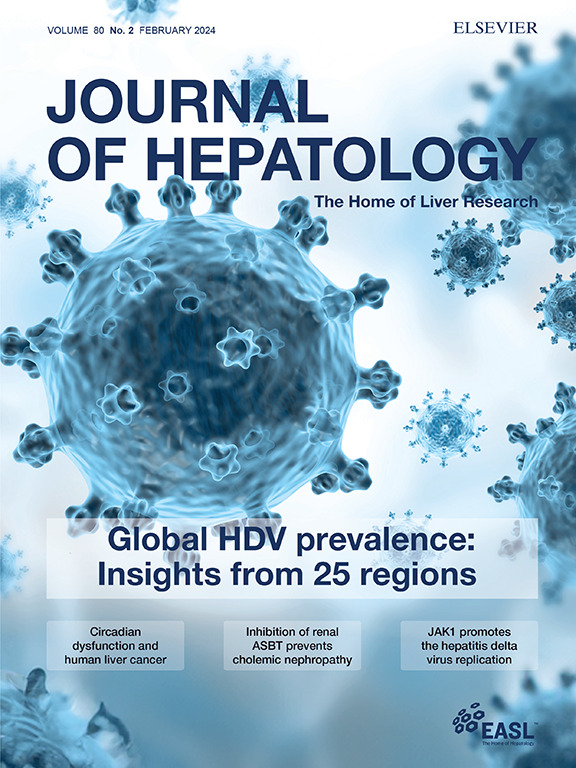A non-inferiority randomised controlled trial of a Shorter Acetylcysteine Regimen for Paracetamol Overdose – the SARPO trial.
IF 26.8
1区 医学
Q1 GASTROENTEROLOGY & HEPATOLOGY
引用次数: 0
Abstract
Background
Paracetamol is a common overdose worldwide. Early acetylcysteine treatment can prevent hepatotoxicity. Multiple intravenous acetylcysteine regimens exist; the commonest recommending 300mg/kg over 20h. We investigated the effectiveness and safety of a shorter regimen in paracetamol overdoses ≤30g.Methods
In a multicentre non-inferiority randomised controlled trial, 204 patients from three hospitals with acute paracetamol overdose ≤ 30g presenting within 8h, were randomised to standard 20h acetylcysteine (200mg/kg/4h, 100mg/kg/16h) regimen or short 12h acetylcysteine (200mg/kg/4h, 50mg/kg/8h) regimen. The primary outcome was the absolute difference between alanine transaminase (ALT) 24h post-ingestion and admission ALT (ΔALT24). Secondary outcomes included ALT>150U/L at 24h and double admission ALT, systemic hypersensitivity and gastrointestinal adverse effects.Results
The two groups were similar in age, gender, dose ingested, paracetamol concentration, baseline ALT, hospital, charcoal administration and time until acetylcysteine. The shorter regimen was non-inferior to the standard regimen. ΔALT24 for 107 patients given the shorter regimen was median -2U/L (Interquartile range [IQR]:-7 to 1U/L) compared to 97 given the standard regimen, median -1U/L (IQR:-5 to 1.5U/L); difference in medians of -1U/L; 95% confidence interval:-3 to 1U/L; less than the upper non-inferiority margin of 5). No patient receiving the shorter regimen had a 24h ALT double admission and >150U/L, compared to one receiving the standard regimen. No patient had an ALT>1000U/L. Systemic hypersensitivity reactions were similar between groups [9/107 (8%) for short versus 10/97 (10%) standard regimen]. Gastrointestinal adverse effects occurred in 78/107 patients (73%) receiving the short versus 63/97 (65%) receiving the standard regimen.Conclusions
The shorter 12h acetylcysteine regimen had the same effectiveness and safety as the standard 20h regimen in acute paracetamol overdoses ≤30g, almost halving the length of treatment required.Trial Registration
Australian New Zealand Clinical Trials Registry number ACTRN12616001617459.

短期乙酰半胱氨酸方案治疗扑热息痛过量的非劣效性随机对照试验- SARPO试验。
背景:扑热息痛是世界范围内常见的过量用药。早期乙酰半胱氨酸治疗可预防肝毒性。存在多种静脉注射乙酰半胱氨酸方案;最常见的建议300mg/kg超过20h。我们研究了对乙酰氨基酚过量≤30g的较短治疗方案的有效性和安全性。方法在一项多中心非效性随机对照试验中,将204例8h内出现急性对乙酰氨基酚过量≤30g的患者随机分为标准20h乙酰半胱氨酸(200mg/kg/4h、100mg/kg/16h)治疗组和短12h乙酰半胱氨酸(200mg/kg/4h、50mg/kg/8h)治疗组。主要终点是摄入后24小时丙氨酸转氨酶(ALT)与入院时ALT的绝对差异(ΔALT24)。次要结局包括24小时ALT>;150U/L和二次入院ALT、全身过敏和胃肠道不良反应。结果两组患者在年龄、性别、服用剂量、扑热息痛浓度、ALT基线、住院时间、炭化给药时间、至乙酰半胱氨酸水平等方面无明显差异。较短的治疗方案并不比标准治疗方案差。ΔALT24在给予较短方案的107例患者中,中位数为-2U/L(四分位数范围[IQR]:-7至1U/L),而给予标准方案的97例患者中位数为-1U/L (IQR:-5至1.5U/L);中位数差-1U/L;95%置信区间:-3 ~ 1U/L;小于上非劣效裕度5)。与接受标准方案的患者相比,接受较短方案的患者没有24小时ALT双入院和>;150U/L。无一例患者血压为1000U/L。两组之间的全身性过敏反应相似[短方案9/107 (8%)vs标准方案10/97(10%)]。接受短方案的患者中有78/107例(73%)发生了胃肠道不良反应,而接受标准方案的患者中有63/97例(65%)发生了胃肠道不良反应。结论在急性对乙酰氨基酚过量≤30g时,较短的12h乙酰半胱氨酸方案与标准20h方案具有相同的有效性和安全性,所需治疗时间几乎缩短了一半。试验注册澳大利亚新西兰临床试验注册编号ACTRN12616001617459。
本文章由计算机程序翻译,如有差异,请以英文原文为准。
求助全文
约1分钟内获得全文
求助全文
来源期刊

Journal of Hepatology
医学-胃肠肝病学
CiteScore
46.10
自引率
4.30%
发文量
2325
审稿时长
30 days
期刊介绍:
The Journal of Hepatology is the official publication of the European Association for the Study of the Liver (EASL). It is dedicated to presenting clinical and basic research in the field of hepatology through original papers, reviews, case reports, and letters to the Editor. The Journal is published in English and may consider supplements that pass an editorial review.
 求助内容:
求助内容: 应助结果提醒方式:
应助结果提醒方式:


